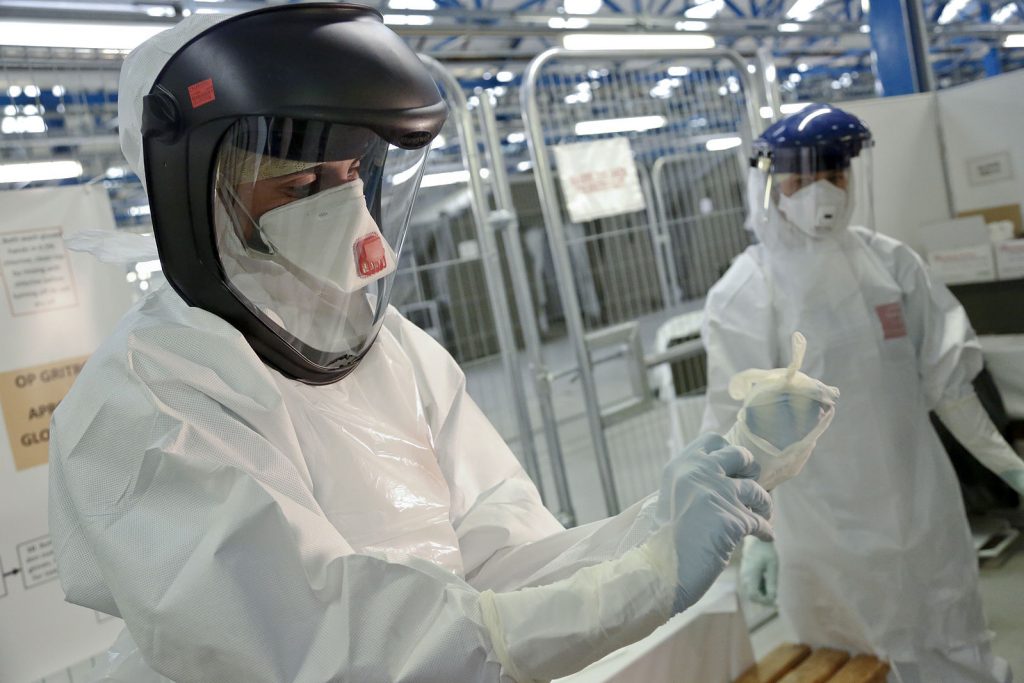Nurse Nina Pham arrived at Texas Presbyterian Hospital in Dallas for her regular shift. The patient that she was assigned to take care of was named Thomas Duncan. Little did she know that this patient would change her life, but not particularly for the better. A few days after Nina met her patient Duncan, she woke up sick. She knew in her heart that she had been contaminated somehow. She was later diagnosed with having the Ebola virus. That day started a long battle for Pham, fighting for her life.

Nina Pham and few other nurses were assigned to take care of Duncan in his most critical state. Nina Pham was his primary nurse, but she was given little information about what disease Duncan was carrying. Nina Pham claims that she lacked the complete training that she needed in order to protect herself. The CDC states that people who care for patients who are suffering from Ebola should have completed comprehensive training on how to protect themselves. According to Dr. Daniel Varga, the chief clinical officer at Texas Presbyterian Hospital, Nina Pham and the other nurses assigned did follow the CDC guidelines for protecting themselves. It is unknown when she came into contact with the disease, but according to Nina Pham, the hospital did not provide everything that it could have to ensure that the nurses were safe. Dr. Varga admitted that the hospital did not have all the resources available at the time and lacked communication, but they still followed the CDC and the state guidelines. By the time Thomas Duncan was moved to the ICU, the nurses began wearing double sets of gloves that were then taped to two gowns. Then they wore two booties and a face shield. Nina Pham claimed that though they were pretty much covered, their necks were still exposed. According to Pham, the nurses were the ones who came up with an arrangement that they felt would better protect themselves. The nurses would use the room next door to place their suits and to clean up after taking care of Duncan. As Duncan got progressively worse, the janitors stopped coming into the room. According to Pham and the three other nurses, they began to work as both janitors and nurses at the same time. They had to clean his bathroom and his room, which made them come into direct contact with his lethal waste. Nina Pham stated that there was so much waste at one point that it could have probably filled half of a patient’s room. It was emotionally and physically draining for the nurses.6 Then, when Duncan died, it left the nurses devastated. It was hard for Nina to lose Duncan, but soon she would be in the same position as him.
Three days later, after Thomas Duncan died, Nina Pham checked herself into the hospital, because she was experiencing a high fever. When she was admitted, she explained who she had taken care of, and what her condition probably was. She was quickly tested for Ebola and indeed tested positive for the disease. The hospital had just recovered from the death of Thomas Duncan, and now it faced another frightening case of Ebola. Nina was immediately placed into isolation. She told an interviewer, “I broke down crying” when she was given the news. All she wanted to do was to do her duty, which now was putting her life at risk. Nina Pham was placed on three experimental drugs. These made her very fatigued, and she claims that she did not remember a lot, due to being in and out of sleep. While she was in treatment, the hospital flew her out to Maryland to be cared for by a very specialized immunologist.7 The doctor was also a scientist and wanted to videotape her recovery in the hospital. This videotape was later released to the public, which became a problem that she dealt with. She knew why the videotaping would be a good thing for science, but she did not want it to be released to the media. Then one day after she was formally diagnosed, the news broke that a doctor named Kent Bently flew into Dallas to donate his blood. This doctor had worked in Liberia and had also contracted Ebola. But he had just beaten the disease, and by donating his blood to her, her blood would then have the antibodies that she would need in order to fight the disease.8 Then, on October 24, 2014, Nina Pham was released from the hospital Ebola-free. This was a victory for the hospital and for her. Though it was a scary time, Nina Pham was able to come out of it whole.

Nina Pham was free of Ebola but she still suffered from the effects of the disease. The doctors told her to be prepared for the long-term effects of Ebola. Some of them are weakening in the sensory nerves, poor vision, and possible failure of organs. She was twenty-six years old at the time when she contracted Ebola. Nina is not sure if she can have children, and whether her children might be affected by the disease. She has also experienced her hair falling out and extreme fatigue. Her liver also produces a high amount of enzymes, which makes it hard for her to eat certain foods.9 As of October 2016, Nina Pham had not returned to work, but was still getting paid regularly. She filed a lawsuit against the hospital, suing for her physical and mental health, medical expenses, and the future loss of earning.10 The specific amount of money that she is suing for is unknown. NBC News reported that it cost up to $30,000 per day to take care of a patient who has Ebola. The prices can increase depending on the severity of the patient. The hospital has to dispose of Ebola patients’ beds, which can cost up to $146,000. Dr. Jeffrey Gold, a school chancellor at the University of Nebraska Medical Center, wanted Congress to create funding and policies that would help to reimburse hospitals that deal with these types of rare diseases.11
Ebola can also affect the economy and the politics of a nation. After the Ebola outbreak, the Obama Administration asked Congress for $6.18 billion to use for emergency funding to help understand rare diseases, and also for how to prevent another outbreak from happening. The money would be parceled to organizations like the CDC, who would receive $1.83 billion. Not only has the United States set up money for a future outbreak and more research, Sierra Leone, Guinea, and Liberia have done the same. Liberia has set aside $812 million dollars, Sierra Leone has put aside $844 million dollars, and Guinea has put aside $2.89 billion.12 Each of these three countries have not only set aside money, but have also created recovery plans. They are all going about the recovery plans in different ways, but they are all aiming for the same thing, which is to update their health care system and work on improvements that will benefit the country. Ebola is not only a hard disease to get rid of, but also an expensive disease. After the Ebola outbreak in 2014, Washington was busy at work trying to figure out ways to reduce the chances of another disease coming into America again. They want to lower the chance of having infected people like Thomas Duncan from bringing Ebola into the United States. The Republican majority in Congress at the time wanted the White House administration to impose a travel ban on West African countries. President Obama did not want to do this because, according to the CDC, a ban would not do much. Instead, the administration wanted to focus on making new safety guidelines to help US healthcare workers deal with diseases like Ebola. Both Democrats and Republicans did settle on making improvements to the hazard suits, training, and education about more diseases for US hospitals.13. Ebola was a real wake up call for America to update their policies and get their priorities straight.Ebola consumes everything in its way. It takes over the victim’s body, the national economy, and a nation’s domestic politics. It is a hard disease to fight and contain. There are many things that scientists need to learn about the disease in order to find more effective cures for it. The 2014 outbreak was like a nightmare that the whole of America woke up to. Thomas Duncan, who lost his life, and Nina Pham, who was close to it, show why it is important for America to rise and take control of its healthcare.
- Nichols Hannah, “Ebola: Symptoms, treatment, and causes,” Medical News Today (May 2017): 1. ↵
- “About Ebola Virus Disease,” Center for Disease Control (February 2016): 1. ↵
- “Ebola virus disease,” World Health Organization (June 2017): 1. ↵
- Richard Preston, The Hot Zone (New York: Random House, 1994), 28. ↵
- Greg Botelho, “Thomas Duncan: First Ebola Death in U.S,” CNN News, (October 2014): 1. ↵
- Jennifer Emily, “Free of Ebola but not fear,” Dallas News (February 2015): 1 ↵
- Frank Heinz, “Pham transported to NIH in Maryland,” NBC-DFW News (October 16, 2014): 1. ↵
- “Dallas nurse battling Ebola says she’s doing well,” ABC News (October 14, 2014). ↵
- Emily Jennifer, “Free of Ebola but not fear,” Dallas News (February 2015): 1. ↵
- Jennifer Emily, “Nurse Nina Pham settles Ebola Lawsuit against Texas Health Resources,” Dallas News (October 2016): 1. ↵
- “Cost to treat Ebola: $1 million for two patients” NBC News (November 2014): 1. ↵
- Zoe Mullan, “The Cost of Ebola,” The Lancet, Vol 3 ( August 2015): 423. ↵
- David Morgan and Toni Clarke, “Republican take aim at US Ebola response after 4th case emerges,” Reuters, (October 24, 2014) 1 ↵



86 comments
Anna Steck
It is really strange to read this after the Covid-19 pandemic because I remember at the beginning thinking that it was nothing to worry about because it would be just like the Ebola virus. It may be a big deal in other countries, but it won’t spread here. This story is still fascinating on its own. It is fortunate that it was not an airborn disease and that the hospital took the appropriate precautions to prevent further spread. The steps they took and the recources available prevented a bigger concern here in the states.
Franchesca Baldwin
It’s fascinating to learn of Ebola’s origin in the US, especially with everything happening right now because of the corona virus. I’m glad the response to disease was fast and well-prepped, as we now understand what happens when it is not. I am glad Nina Pham turned out alright, and hopefully the disparities in how far the diseases spread will serve as an important precedent, even if COVID is airborn rather than caught through contact.
Cristianna Tovar
I remember the sheer terror that everyone felt from the Ebola outbreak like it was just yesterday. It’s hard to imagine that it happened five years ago! This article was very informative about the Ebola virus and its effect on the human body. It’s very scary to think that one person who is infected with a certain disease can cause a domino effect and it can spread across an entire country. I was glad that after the Ebola outbreak happened, the United States and other countries set aside money and created recovery plants that will help prevent another event like this from happening again.
Saira Locke
The Ebola epidemic was a huge deal a few years ago. It seemed as though everyone was dying. I understand why the hospitals at the time were not trained for this disease because it had not come up before for the hospitals to know what to expect. I believe that nurse Nina Pham should win her lawsuit against the hospital because it is essentially their fault for her contracting the disease and possibly dying because they weren’t well enough equipped for the possibility of this kind of disease. They also should have trained their nurses for this possibility that happened to occur.
Jacob Silva
Back in 2014, I had to have been in 7th grade and I vaguely remember a month where every news headline was about ebola, but nothing more than that, I only knew the virus’s name. I can honestly and confidently say that I absolutely did not know the virus came to the US, I only thought it was only a problem across the Atlantic. Hearing how people trying to help with helping the sick only to contract the virus themselves is saddening. Hearing how poorly the virus was contained makes me think the US needs to take stronger measures to contain a virus in the future.
Cynthia Perez
I never realized how bad of a virus Ebola actually is. Taking control and destroying a person’s insides. That’s severely scary, yet it’s amazing and unfortunate learning about Nina Pham’s story where she intentionally was directed to help a patient fight through this disease, just to then fall victim to it herself. Overall great article! Really gave an insight into something I’ve only heard of but didn’t understand when it came to such a rare medical problem/near epidemic.
Nicholas Hatch
I remember first hearing about this deadly disease and how scared it got everybody. Nina Pham was doing her job and was given the task of taking care of Thomas Duncan who had been infected with ebola. Unfortunately, the disease was irreversible at this point and Duncan passed away. While taking care of her patient Nina Pham had contracted the disease, luckily she was able to cure the disease by getting blood from another person who had just beat the disease. His blood contained antibodies needed to fight disease. Luckily she survived. It’s very respectable that Nina was ready and willing to help. Great article!
Ashley Martinez
Back in 2014 I distinctly remember hearing about the Ebola outbreak, this caused panic everywhere. There were so many people that died from this awful disease. Nina Pham did her job as a nurse caring for her patient Thomas Duncan even though this disease was very deadly and harmful. Duncan unfortunately passed away, but Nina was left fighting for her life. Ebola had slowly taken over her body, but she was given certain antibiotics and blood from another individual who had just overcome the disease. This man’s blood had antibodies in his blood that helped him fight the infection. This helped save Nina’s life. Although she is alive she will suffer certain medical impacts from time to time. This article shows that all medical providers from nurses to doctors to everyone in between plays a vital role in every patient’s life. We should be so thankful for people like Nina who truly care about their patients and the impact they leave upon them.
Bianca-Rhae Jacquez
During the Ebola crisis everyone around the world was scared that it would get to them. I had forgotten that the virus had reached the United States. Its sad that the people that tried helping the sick, such as Nina Pham, were infected with the virus themselves. It was hard for the virus to be contained medically. Even though the virus wasn’t as bad it could’ve been it did have a strong impact.
Diego Terrazas
Back when I first heard about the outbreak, I believed it may turn into a worldwide epidemic. I completely forgot the virus reached the United States. Perhaps we can work on preparing for future virus outbreaks, financially and medically, so that we can prevent the virus from reaching unprecedented levels. It may be expensive but I believe it is crucial to prepare for such crisis’.